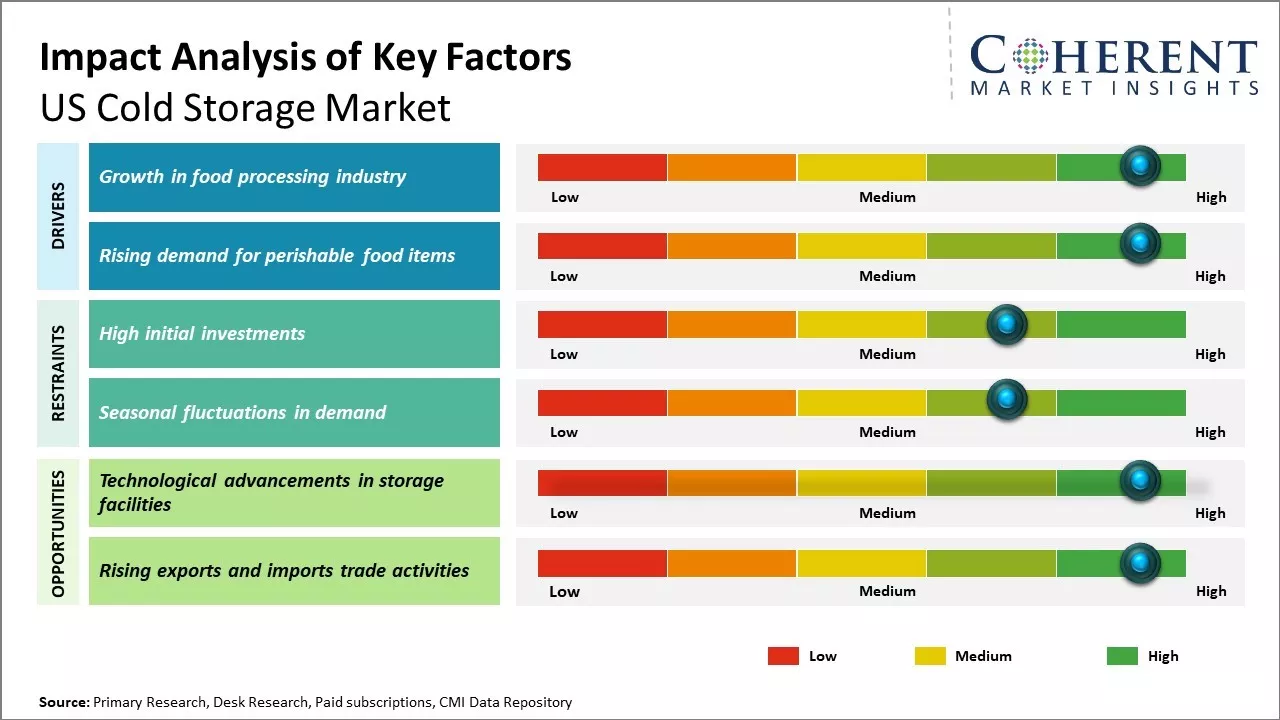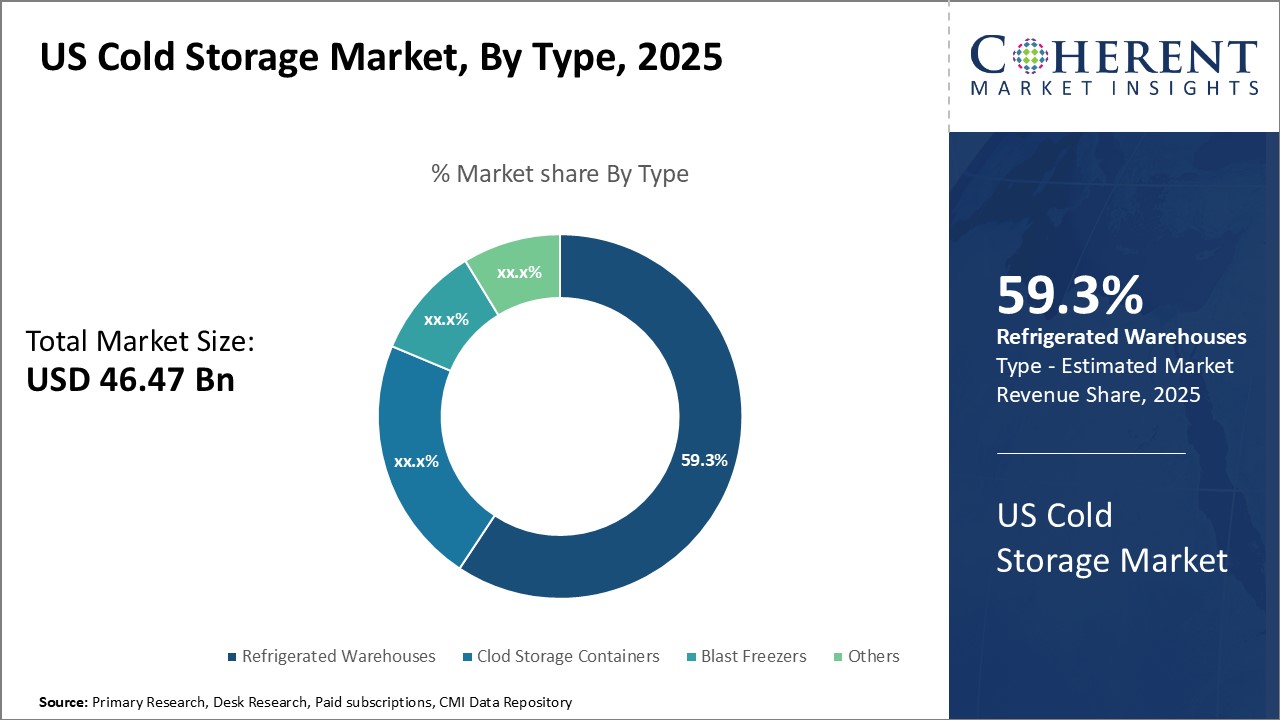US Cold Storage Market Size and Trends
The US cold storage market is estimated to be valued at USD 46.47 Bn in 2025 and is expected to reach USD 104.75 Bn by 2032, exhibiting a compound annual growth rate (CAGR) of 12.3% from 2025 to 2032.

Discover market dynamics shaping the industry: Download Free Sample
The cold storage market in the US is expected to witness significant growth during the forecast period driven by rising consumption of perishable foods such as dairy products, fruits & vegetables, meat, and seafood. There is growing demand for temperature-controlled warehousing and transport vehicles to store and transfer perishable products seamlessly. Furthermore, increasing consumer expectations regarding product availability throughout the year and rising penetration of e-commerce are fueling the demand for cold storage facilities in the country. Rapid urbanization and changing lifestyles are also contributing to the growth of the U.S. cold storage market.
Growth in food processing industry
The food processing industry in the U.S. has seen tremendous growth over the past few decades. For instance, in 2022, the economic output of the food manufacturing industry in the U.S., measured by Gross Regional Product (GRP), and reached an impressive US$181 billion. This figure represents just over 1% of the total economic output across all industries in the U.S., highlighting the vital role that food processing plays in the national economy. As consumer demand and tastes have evolved, more and more food items are undergoing various processing methods before reaching the shelves. This involves activities like baking, cooking, freezing, canning, packing, and others. As the demand for processed and packaged food has increased sharply, it has propelled food manufacturers to ramp up production. However, producing such large volumes of food comes with its own set of challenges. Perishable raw materials and semifinished goods need to be stored properly to ensure quality and safety. This is where cold storage facilities have become extremely important.
Most food processing plants now outsource their cold storage needs rather than establishing in-house infrastructure. Advanced cold storage warehouses with state-of-the-art refrigeration systems provide ideal temperature and humidity-controlled environments for short as well as long-term storage of various agro commodities and food items. Being able to store raw materials efficiently especially during the harvest season ensures undisrupted production activities in food plants throughout the year. Likewise, finished food products can also be kept in optimal conditions in cold warehouses before being shipped to different distribution channels. This ability of third-party cold chains to act as an extension of the production facility has vastly helped food manufacturers to scale up their operations.
The trends of consolidation and mergers & acquisitions in the food industry have further boosted demands on cold storage. When two or more companies integrate their businesses, there is a need to centrally warehouse all inventory. Centralized storage management becomes vital to maintain control over supplies and meet production needs of multiple facilities. Advanced cold storage hubs have effectively addressed such requirements of combined inventory handling from large conglomerates. As the food processing sector expands continuously to meet growing consumption, it will keep relying on cold chains for uninterrupted production turnover and ensuring product freshness all year round.
Market Concentration and Competitive Landscape

Get actionable strategies to beat competition: Download Free Sample
Rising demand for perishable food items
Changing demographics and lifestyles have increased the consumption of perishable food categories tremendously over the past decades. For instance, according to the U.S. Department of Agriculture (USDA), the sales of fresh fruits and vegetables increased dramatically during the pandemic. For example, fresh produce sales rose by over 20% in the early months of 2020 compared to the previous year, as consumers sought healthier food options to boost their immune systems. Younger population is consuming fresher, single-serve, and convenient packaged products. There is also a rising health and wellness trend where consumers prefer natural, fresh, and minimally processed foods. Expenditure on perishables like fruits, vegetables, seafood, meat, and dairy has seen robust growth. Likewise, the consumption of exotic fruits and vegetables has also risen which need special cold chain handling. Meeting this exponential demand spike for such perishable items requires a robust cold storage infrastructure.
Modern retail formats like supermarkets and online grocery platforms also drive the need for cold logistics. Supermarkets maintain large displays of fruits, vegetables, and refrigerated sections to attract customers. They need a consistent supply of quality produce throughout the year which can only be ensured through efficient cold storage network. Similarly, e-commerce channels expanding in grocery delivery keep pushing the need for multiple temperature-controlled distribution and fulfillment centers. As customers increasingly expect very fast delivery, retailers rely on optimized cold storage locations situated strategically closer to demand pockets.
Moreover, customers today demand variety and off-season availability of produce. Advanced cold storage facilitates long-distance movement of perishables and their storage for extended periods without loss of quality. This has enabled year-round supplies of seasonal items in domestic markets. It has also supported exports of perishable commodities globally. All these factors related to dynamic consumption patterns and modernizing retail are stimulating significant investments in new cold storage construction as well as technological advancements in existing infrastructure.
Key Takeaways from Analyst:
The U.S cold storage market is expected to experience steady growth over the next five years driven by growing demand for perishable foods and increasing focus on reducing food wastage. The food processing industry will drive much of the cold storage needs due to the surge in packaged and processed food consumption in the country. Furthermore, the booming e-commerce industry is likely to provide a fillip to cold storage requirements for quick deliveries of perishable items to customers.
However, high initial investments and operating costs remain a constraint and could hamper growth prospects to an extent. The market also faces challenges arising from rising energy costs and stringent government regulations around food safety and quality.
That said, the agriculture-rich Midwest and Western regions continue to dominate the US cold storage market landscape due to a strong supply base and proximity to major consumption hubs on the coasts. California, in particular, stands to benefit the most given the large agricultural output and critical role of its ports in food exports and imports. Meanwhile, cities in Texas and the Southeast are likely to witness the fastest capacity additions to support their rapidly growing populations and vibrant economies.
Market Challenge - High initial investments
The key challenge faced by players in the US cold storage market is the high initial investments required to set up such facilities. Cold storage warehouses involve extensive infrastructure like temperature-controlled storage space, refrigeration systems, loading docks and transport facilities. The insulation, temperature and humidity control mechanisms along with safety and handling equipment entail substantial capital expenditure. Moreover, additional funds are needed for maintenance and regular upgrading of technology to ensure product quality is preserved as per food safety standards. The costs escalate for centralize facilities handling large volumes of inventory. The long payback periods and uncertainty over consistent supply contracts make it difficult for new entrants and small businesses to justify such investments.
Market Opportunity: Technological Advancements in Storage Facilities
One of the major opportunities for the U.S. cold storage market is the technological advancements happening in storage facility operations and management. The integration of automation, Internet of Things (IoT), robotics and analytics is enhancing efficiency while reducing operational expenses. Solutions like GPS enabled trucks, automated warehousing, temperature monitoring systems and remote asset tracking tools are being increasingly adopted. Advanced energy management systems with renewable integration are helping lower electricity costs as well. Furthermore, technologies for controlled/modified atmosphere storage broaden the scope of products that can be handled. The evolving digital infrastructure and emergence of smart cold solutions are capable of optimizing capacity utilization, minimizing spoilage and improving supply chain responsiveness. This helps attract new customers and ensures competitive edge for storage providers.

Discover high revenue pocket segments and roadmap to it: Download Free Sample
Insights by type: Increased demand for cold chain infrastructure
In terms of type, the refrigerated warehouses segment estimated to contribute the highest market share of 59.3% in 2025. The refrigerated warehouses segment dominates the U.S. cold storage market due to strong demand from the food and beverage industry for efficient cold chain infrastructure. Refrigerated warehouses provide temperature-controlled, high-density storage solutions to ensure optimal preservation of perishable goods. They allow food producers and processors to store large volumes of products in a centralized facility at precise temperatures as required by the goods.
The popularity of refrigerated warehouses is driven by the need for consistency in product quality throughout the cold chain. Storing goods in large, professionally-run refrigerated facilities helps maintain standardized temperature conditions from production to distribution. This helps reduce spoilage and ensures products meet quality parameters when they reach retailers and consumers. The centralization of storage also enhances load management and transport optimization for suppliers. With concerns around food safety and waste increasing, refrigerated warehouses provide reliable cold storage that extending shelf-life and upholding safety.
Insights by application: Substantial demand for preservation of perishable products
In terms of application, the food & beverages segment is estimated to contribute the highest market share of 38.6% in 2025. The food and beverage segment has the largest share in the U.S. cold storage market due to the immense need for preserving wide varieties of perishable food items. As the food industry in the country churns out massive volumes of perishables daily, robust cold storage infrastructure is paramount. A diverse range of items from meat, seafood and poultry to fruits, vegetables and dairy require temperature-controlled storage conditions to avert spoilage during warehousing and distribution.
Furthermore, rising health-consciousness and demand for fresh, high-quality food items all-year round is propelling the cold chain industry. Cold storage allows food companies to offer perishables outside their region-specific seasons, meeting consumer demand. It also helps consolidate supply networks and maintain steady inventory levels for retailers. Stringent food safety regulations also necessitate reliable cold storage compliance. With the organic food trend gaining ground, cold storage players such as Lineage Logistics, Americold Logistics and other are enhancing facilities with specialized cooling and differential atmosphere controls for high-value organic produce. Innovation in packaging and automated cold storage technologies further spurs the food and beverage cold storage vertical.
Market Report Scope
US Cold Storage Market Report Coverage
| Report Coverage | Details | ||
|---|---|---|---|
| Base Year: | 2024 | Market Size in 2025: | USD 46.47 Bn |
| Historical Data for: | 2020 To 2024 | Forecast Period: | 2025 To 2032 |
| Forecast Period 2025 to 2032 CAGR: | 12.3% | 2032 Value Projection: | USD 104.75 Bn |
| Segments covered: |
|
||
| Companies covered: |
Lineage Logistics, Americold Logistics, U.S. Cold Storage, Inc., Interstate Warehousing, Inc., FreezPak Logistics, Conestoga Cold Storage, Burris Logistics, Vertical Cold Storage, ColdPoint Logistics, SnoTemp Cold Storage, Interstate Cold Storage, Inc., Central Storage & Warehouse LLC, Valley Cold Storage & Transportation, Interchange Group LLC, CWI Logistics, MWCold, Bellingham Cold Storage Co., CTW Logistics, Kloosterboer, and VersaCold Logistics Services |
||
| Growth Drivers: |
|
||
| Restraints & Challenges: |
|
||
Uncover macros and micros vetted on 75+ parameters: Get instant access to report
US Cold Storage Industry News
- On 11 August 2024, the opening of a state-of-the-art MEDLOG cold storage facility marked a significant boost for U.S. meat exports. This advanced facility is designed to enhance the efficiency and capacity of cold storage logistics, ensuring that U.S. meat products are stored and transported under optimal conditions. By improving supply chain capabilities, the MEDLOG facility aims to meet the growing global demand for high-quality U.S. meat, facilitating faster and more reliable exports. This development not only strengthens the competitiveness of U.S. meat in international markets but also supports the overall growth of the agricultural sector.
- In December 2022, Interstate Warehousing, a subsidiary of Tippmann Group, a Logistics and Warehousing company, announced the expansion of its cold storage facilities by holding a groundbreaking ceremony in Kingman, Arizona. The new facility, built on a 92-acre site, aims to address the growing demand for cold storage solutions on the West Coast.
- In September 2022, Lineage Logistics Holding, LLC, a leading temperature-controlled industrial REIT and logistics solutions provider, finalized the acquisition of Grupo Fuentes, a prominent transport and cold-storage facility operator based in Murcia, Spain. The deal, initially announced on August 2, 2022, marks a significant milestone in Lineage Logistics' expansion strategy in the European market.
- In December 2020, Americold Logistics, Inc., a leading global temperature-controlled warehousing and logistics provider, acquired Agro Merchants Group for a staggering USD 1.59 billion. This strategic move allowed Americold to expand its global footprint and strengthen its position in the temperature-controlled logistics market. By integrating Agro Merchants Group's extensive network of cold storage facilities and expertise in the food and beverage industry, Americold aimed to enhance its service offerings and better serve its customers worldwide. The acquisition was a testament to Americold's commitment to growth and its recognition of the increasing demand for reliable and efficient temperature-controlled supply chain solutions in the market.
*Definition: The U.S. cold storage market refers to the industry involved in the storage of perishable goods at controlled temperatures to prolong shelf life and maintain product quality. This market encompasses facilities and services for refrigeration and freezing of food items, pharmaceuticals, and other temperature-sensitive products. It plays a crucial role in the supply chain, ensuring the safe and efficient distribution of goods while meeting regulatory standards for food safety and quality. The market is driven by increasing demand for fresh and frozen foods, e-commerce growth, and advancements in cold storage technologies.
Market Segmentation
- By Type Insights (Revenue, USD Bn, 2020 - 2032)
- Refrigerated Warehouses
- Cold Storage Containers
- Blast Freezers
- Others
- By Application Insights (Revenue, USD Bn, 2020 - 2032)
- Food & Beverages
- Meat & Seafood
- Dairy Products
- Fruits & Vegetables
- Frozen Foods
- Pharmaceuticals
- Chemicals
- Others
- Food & Beverages
- Key Players Insights
- Lineage Logistics
- Americold Logistics
- United States Cold Storage, Inc.
- Interstate Warehousing, Inc.
- FreezPak Logistics
- Conestoga Cold Storage
- Burris Logistics
- Vertical Cold Storage
- ColdPoint Logistics
- SnoTemp Cold Storage
- Interstate Cold Storage, Inc.
- Central Storage & Warehouse LLC
- Valley Cold Storage & Transportation
- Interchange Group LLC
- CWI Logistics
- MWCold
- Bellingham Cold Storage Co.
- CTW Logistics
- Kloosterboer
- VersaCold Logistics Services
Share
Share
About Author
Yash Doshi is a Senior Management Consultant. He has 12+ years of experience in conducting research and handling consulting projects across verticals in APAC, EMEA, and the Americas.
He brings strong acumen in helping chemical companies navigate complex challenges and identify growth opportunities. He has deep expertise across the chemicals value chain, including commodity, specialty and fine chemicals, plastics and polymers, and petrochemicals. Yash is a sought-after speaker at industry conferences and contributes to various publications on topics related commodity, specialty and fine chemicals, plastics and polymers, and petrochemicals.
Missing comfort of reading report in your local language? Find your preferred language :
Transform your Strategy with Exclusive Trending Reports :
Frequently Asked Questions
EXISTING CLIENTELE
Joining thousands of companies around the world committed to making the Excellent Business Solutions.
View All Our Clients
